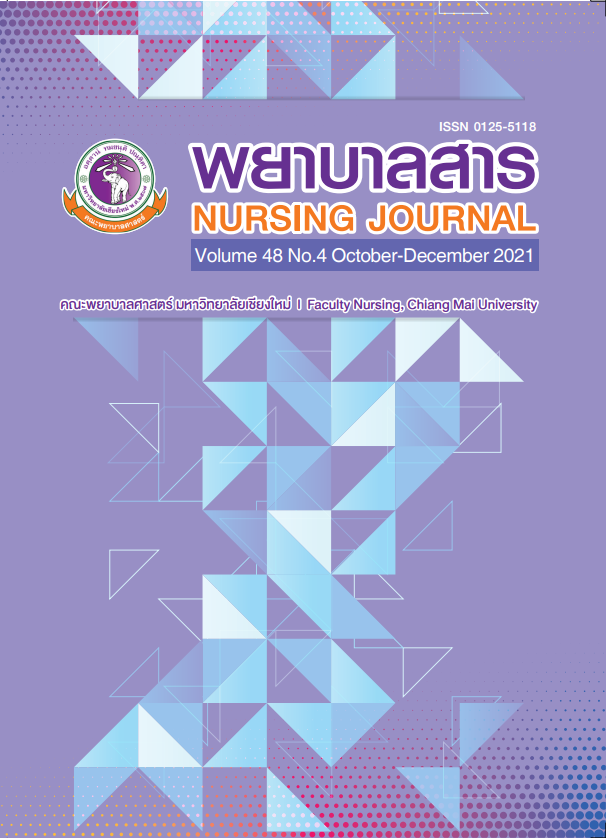การพัฒนารูปแบบการดูแลผู้ป่วยวิกฤตโดยใช้แนวคิด FAST HUG ในหอผู้ป่วยหนักอายุรกรรมและศัลยกรรม โรงพยาบาลเชียงรายประชานุเคราะห์
คำสำคัญ:
การพัฒนารูปแบบการดูแล, ผู้ป่วยวิกฤต, แนวคิด FAST HUG, concept แนวคิด Proctorบทคัดย่อ
ผู้ป่วยวิกฤตที่เข้ารับการรักษาในหอผู้ป่วยหนัก เป็นผู้ที่มีภาวะความเจ็บป่วยที่รุนแรงคุกคามชีวิต อาการเปลี่ยนแปลงอย่างรวดเร็ว เกิดภาวะแทรกซ้อนรุนแรงได้ในทุกระบบของร่างกาย การวิจัยนี้มีวัตถุประสงค์เพื่อพัฒนารูปแบบการดูแลผู้ป่วยวิกฤตโดยใช้แนวคิด FAST HUG ในหอผู้ป่วยหนักอายุรกรรมศัลยกรรม โรงพยาบาลเชียงรายประชานุเคราะห์ ตามกรอบแนวคิดการวิจัยเชิงปฏิบัติการของ เคมมิส และแมคทากกาท (Kemmis & Mc Taggart, 1988) และการดูแลใช้กรอบแนวคิด FASTHUG (Vincent, 2005) ซึ่งจะช่วยให้ผู้ป่วยวิกฤตได้รับการดูแลอย่างเป็นองค์รวมครอบคลุมทุกประเด็นปัญหาสำคัญและป้องกันการเกิดผลลัพธ์ไม่พึงประสงค์ได้อย่างมีประสิทธิภาพ การวิจัยเชิงปฏิบัติการแบบมีส่วนร่วมครั้งนี้ มี 2 วงรอบ ร่วมกับการนิเทศทางคลินิกตามแนวคิดของพรอคเตอร์ (Proctor, 2010) เพื่อเสริมสร้างทัศนคติที่ดีต่อการนิเทศ การปฏิบัติงาน และมุ่งพัฒนาความรู้และทักษะในการดูแลผู้ป่วยวิกฤตแบบเป็นทีม กลุ่มตัวอย่างทีมพัฒนารูปแบบประกอบด้วยหัวหน้าหอผู้ป่วย 8 คน พยาบาลวิชาชีพ 48 คน ผู้ป่วย 451 ราย เครื่องมือการวิจัยจำนวน 5 ชุด ได้ผ่านการหาความเชื่อมั่นและหาความเที่ยงตรงแล้ว วิเคราะห์ข้อมูลเชิงคุณภาพด้วยการวิเคราะห์เนื้อหา และวิเคราะห์เปรียบเทียบผลลัพธ์ของรูปแบบการดูแลผู้ป่วยวิกฤตโดยใช้แนวคิด FAST HUG โดยใช้สถิติพรรณาได้แก่ paired t-test, Independent t-test, exact probability test ผลการวิจัยพบว่า 1. รูปแบบการดูแลผู้ป่วยวิกฤตที่พัฒนาขึ้นโดยใช้แนวคิด FAST HUG มีองค์ประกอบด้วย 7 ด้าน ได้แก่ 1) F: Fluid & Feed ดูแลให้ได้รับอาหารและสารน้ำ ภายใน 24-72 ชั่วโมง 2) G: Glucose การเฝ้าระวังและการควบคุมระดับน้ำตาลในเลือดให้อยู่ระดับ 80-180 mg% 3) S: sedation การใช้ยาระงับประสาท เน้นประเมินเพื่อหยุดให้ยาโดยเร็ว เพิ่มการประเมิน โดยใช้ RASS score 4) A: Analgesic ประเมินอาการปวดโดยเพิ่มการประเมินด้วย CPOT และพิจารณาการงดใช้ยาโดยเร็วภายใน 24-48 ชม. 5) H:Head of bed การจัดท่านอนหัวสูงอย่างน้อย 30 องศา 6) T: Thromboembolic prevention การให้ยาป้องกันการเกิดภาวะลิ่มเลือดในหลอดเลือดดำอุดตัน โดยเพิ่มการคัดกรองกลุ่มเสี่ยงอายุ >60 ปี หรือผู้ป่วยที่มีต่อมลูกหมากโต และ 7) S:Stress ulcer prophylaxis ป้องกันการเกิดแผลในกระเพาะอาหาร โดยดูแลให้ได้รับยากลุ่ม PPI ภายใน 24-72 ชม 2. ผลลัพธ์จากการใช้รูปแบบการดูแลพบว่า พยาบาลวิชาชีพมีความรู้ในการดูแลผู้ป่วยหนักเพิ่มขึ้นอย่างมีนัยสำคัญทางสถิติ (p<0.001) มีความพึงพอใจต่อการใช้รูปแบบในระดับดีร้อยละ 31 และระดับดีมากร้อยละ 69 หัวหน้าหอผู้ป่วยมีความพึงพอใจในการนิเทศแนวทางใหม่ในระดับดีร้อยละ 62.5 และระดับดีมาก ร้อยละ 37.5 3. ผลลัพธ์ที่เกิดขึ้นกับผู้ป่วย พบว่า อัตราการเสียชีวิตลดลงจาก ร้อยละ 14.23 เหลือร้อยละ 12.04 อัตราการเกิดปอดอักเสบจากการใช้เครื่องช่วยหายใจ ลดลงจาก ร้อยละ 5.77 เหลือร้อยละ 1.57 การหย่าเครื่องช่วยหายใจไม่สำเร็จ ลดลงจากร้อยละ 13.5 เหลือร้อยละ 6.28 ระยะเวลาในการนอนในหอผู้ป่วยหนักลดจาก 6.73 วัน เหลือ 5.62 วัน ค่าใช้จ่ายในหอผู้ป่วยหนักเฉลี่ยลดลงจาก 123,075 บาทเหลือ 92,109 บาท รูปแบบการดูแลที่พัฒนาขึ้นมีความเหมาะสมกับการดูแลผู้ป่วยวิกฤต สามารถเพิ่มคุณภาพการพยาบาลได้อย่างมีประสิทธิภาพ
เอกสารอ้างอิง
Abhijit, S. N., Vibhavari, M. N., & Basanth K. R. (2017). FAST HUGS BID: Modified mnemonic for surgical patient. Indian Journal Critical Care Medicine, 21(10), 713–720.
Armahizer, M. J., & Benedict, N. J. (2021). FAST HUG: ICU Prophylaxis. American Society of Health-System Pharmacists, 35, 1-11.
Kemmis, S., & McTaggart, R. (1988). The action research planner (3rd ed.). Geelong, Australia: Deakin University Press.
Mabasa, V. H., Malyuk, D. L., Weatherby, E. M., & Chan, A. (2011). A standardized, structured approach to identifying drug-related problems in the Intensive Care Unit: FASTHUG-MAIDENS. The Canadian Journal of Hospital Pharmacy, 64(5), 366–369.
Magnan, G. B., Vargas, R. S., Lins, L. F., Mendonça, K. R., Barbosa, M., Rocha, P. R., & Maia, M. O. (2009). FAST HUG in an ICU at a private hospital in Brasília: Checklist and the eighth evaluation item. Critical Care, 13(Suppl 3), 1-9.
Monares, Z. E., & Galindo, M. CA. (2015). Giving a nutritional fast hug in the intensive care unit. Nutrition Hospital, 31(5), 2212–2219.
Muangin, W., Akarawanasakun, B., Wongkaew, O., & Mongkhonittivech, N. (2020). Outcomes of nursing clinical practice guideline development for septic shock in medical intensive care unit at Chiang Rai Prachanukroh Hospital. Journal of Nursing Science & Health, 43(1), 97-108. (in Thai)
Papadimos, T. J., Hensley, S. J., Duggan, J. M., Khuder, S. A., Borst, M. J., Fath, J. J, ... Buchman, D. (2008). Implementation of the “FASTHUG” concept decreases the incidence of ventilator-associated pneumonia in a surgical Intensive Care Unit. Patient Safety Surgery, 12, 2-3. doi: 10.1186/1754-9493-2-3
Proctor, B. (2010). Training for the supervision alliance attitude, skills and intention In
Fundamental Themes in Clinical Supervision: 25–46. London: Routledge.
Pukkham, K., & Wisettharn, T. (2016). Development of clinical guideline for surgical nursing practice in intensive care unit based on FAST HUG concept. Journal of Health Science, 25(1), 116-127. (in Thai)
Suranatchayanan, P., Kenthongdee, W., & Kamonrat, S. (2018). Nursing care system development for sepsis patients at Loei Hospital. Journal of Nursing and Health Care, 36(1), 207-215. (in Thai)
Uppanisakorn, S., & Boonyarat, J. (2014). Caring for intensive care unit patients: Application of the FASTHUG and BANDAIDS concepts. Thai Journal of Nursing Council, 29(3), 19-30. (in Thai)
Vincent, J. L. (2005). Give your patient a fast hug (at least) once a day. Critical Care Medicine, 33(5), 1212–1219.
Vincent, W. R., & Hatton, K. W. (2009). Critically ill patients need “FAST HUGS BID” (an updated mnemonic). Critical Care Medicine, 37(7), 2326–2337.
ดาวน์โหลด
เผยแพร่แล้ว
รูปแบบการอ้างอิง
ฉบับ
ประเภทบทความ
สัญญาอนุญาต
บทความที่ได้รับการตีพิมพ์เป็นลิขสิทธิ์ของวารสารพยาบาลสาร
ข้อความที่ปรากฏในบทความแต่ละเรื่องในวารสารวิชาการเล่มนี้เป็นความคิดเห็นส่วนตัวของผู้เขียนแต่ละท่านไม่เกี่ยวข้องกับมหาวิทยาลัยเชียงใหม่ และคณาจารย์ท่านอื่นๆในมหาวิทยาลัยฯ แต่อย่างใด ความรับผิดชอบองค์ประกอบทั้งหมดของบทความแต่ละเรื่องเป็นของผู้เขียนแต่ละท่าน หากมีความผิดพลาดใด ๆ ผู้เขียนแต่ละท่านจะรับผิดชอบบทความของตนเองแต่ผู้เดียว






